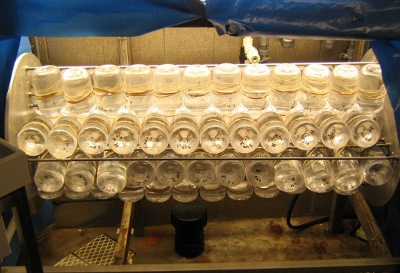Plankton wheel with incubation bottles. Photo: H. Horn, AWI
When the news about the bloom finally kicking in reached me on the lovely but remote island of Helgoland, it was time to pack and to go back to Kristineberg.
The“Dune ferry – plane to the mainland – train to Kiel – ferry to Gothenburg – bus ride to Kristineberg” routine sounds easy enough. But when you are in a hurry, of course you pick the first day in weeks where thick clouds lead to cancellation of one flight after another, as the airport is so small they have to start and land by sight. I was lucky to be on the only flight of the day – so there you are in that tiny propeller machine over the North Sea, seeing nothing at all, just like the pilot.
I thought the weather in Sweden would be different by now, with all the sunshine my colleagues told me about, but we got rain and hail and lots of wind the day we went out for sampling. Well, with the right drivers, fighting the elements can be actually quite funny. So I could start my microzooplankton grazing experiments right at the peak of the bloom, thanks to Tim and Jess.
Did you know a plankton wheel can be loaded with 96 incubation bottles…? It is quite a useful tool to keep the plankton from just sinking down, turning the bottles at a slow speed while avoiding shaking them too much.
It is hard to believe that despite of the short linear distance, the way back took 3 days. Bus to Gothenburg – ferry to Kiel (of course there was an accident blocking the street for normal traffic, but even 15 minutes late for check-in you are allowed to enter the ferry… fortune favors fast runners!) – train to Bremen next morning – spend another day on the mainland – drive to Cuxhaven next morning – ferry to Helgoland. Home again!
Spring brings sunshine and incredible amounts of tourists to the red sandstone rock and its sandy second half, the Dune, mostly due to duty-free shopping … I mean the unique beauty of Germany’s only off-shore island. As my institute is right next to the harbor, the way takes just 3 minutes, a good thing if your suitcase contains lots of heavy water samples.
Well, it is time now to switch from field work to counting plankton samples under the microscope. But I am sure the results of the experiments will be worth the time spent on the road.
